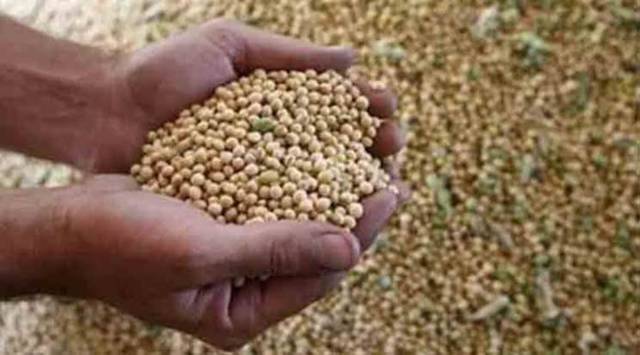Stay updated with the latest - Click here to follow us on Instagram
At PAU, IARI Delhi director lists benefits of growing soybean
While speaking to The Indian Express during his two-day visit to Punjab Agriculture University (PAU), Ludhiana, Singh said that farners in Punjab are dependent on cereal-based mono-cropping and grow only wheat and paddy during Kharif and Rabi seasons, respectively, and if they shift to soybean, they will get better remuneration compared to paddy.
 Soybean has the potential to replace around 30% of paddy area in Punjab, which means nearly 9 lakh hectares can be reduced from the current around 30 to 31 lakh hectare area under rice cultivation. (Representational image)
Soybean has the potential to replace around 30% of paddy area in Punjab, which means nearly 9 lakh hectares can be reduced from the current around 30 to 31 lakh hectare area under rice cultivation. (Representational image)Listing out the benefits of crop diversification, director of New Delhi-based Indian Agriculture Research Institute (IARI) AK Singh said that shift from paddy to soybean in Punjab will not only save groundwater but is also a economically viable option.
While speaking to The Indian Express during his two-day visit to Punjab Agriculture University (PAU), Ludhiana, Singh said that farners in Punjab are dependent on cereal-based mono-cropping and grow only wheat and paddy during Kharif and Rabi seasons, respectively, and if they shift to soybean, they will get better remuneration compared to paddy.
He added that Madhya Pradesh and Maharashtra, which grow soybean on 5 million and 4.5 million hectares, respectively, usually sow the 90-100 days variety and get an yield of 1 to 1.2 tonnes per hectare. These two states sow wheat by October end to be able to harvest it by mid-March before the temperatures go up.
“However, Punjab farmers sow wheat in November and harvest it mid-April and this gives them more time to grow longer duration (130 to 135 days) of soybean varieties. This variety is sowed in the US and South America and gives an yield of about 3.5 to 4.5 tonnes per hectares. In Punjab, one can expect 3 tonnes per hectare,” he said, adding that with soybean cultivation, Punjab farmers can advance the wheat sowing to October 25.
Soybean has the potential to replace around 30% of paddy area in Punjab, which means nearly 9 lakh hectares can be reduced from the current around 30 to 31 lakh hectare area under rice cultivation, Singh said.
He added that the switch will not only help the state to embark upon the much-needed path of diversification but will also decrease the dependency on imports of edible oil. The country imports around 4.5 million tonnes soybean oil every year.
Besides, the average cost of cultivation of soybean per hectare is around Rs 30,000 while in the case of paddy it is
around Rs 50,000 per hectare, Singh said.
“Currently the MSP of paddy is Rs 2,060 per quintal while the MSP of soybean is Rs 4300 per quintal so from this calculation, farmers will get around Rs 1.44 lakh per hectare from paddy and from soybean, he will earn around 1.29 lakh per hectares. After deducting the expenditure, the return from the soybean is more than that of paddy. The return will be more with high yielding variety of soybean,” he said, adding that the crop saves power.
The crop requires fewer fertilisers/chemicals and improves the soil health, it also provides quality soybean oil cake, which is used in animal feed.







